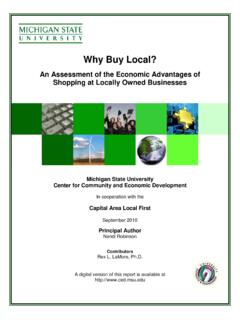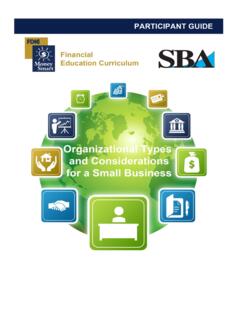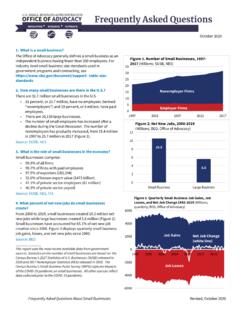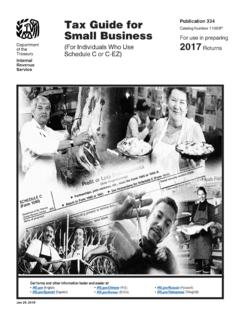Transcription of SBA’s 8(a) Program: Overview, History, and Current Issues
1 SBA s 8(a) Program : overview , history , and Current Issues Updated March 9, 2022 Congressional Research Service R44844 SBA s 8(a) Program : overview , history , and Current Issues Congressional Research Service Summary The 8(a) business Development Program commonly known as the 8(a) Program provides participating small businesses with training, technical assistance, and contracting opportunities in the form of set-aside and sole-source awards. A set-aside award is a contract in which only certain contractors may compete, whereas a sole-source award is a contract awarded, or proposed for award, without competition.
2 In FY2020, 8(a) firms were awarded $ billion in federal contracts, including $ billion in 8(a) set-aside awards and $ billion in 8(a) sole-source awards. Other programs provide similar assistance to other types of small businesses ( , women- owned , HUBZone, and service-disabled veteran- owned ). 8(a) Program eligibility is generally limited to small businesses unconditionally owned and controlled by one or more socially and economically disadvantaged individuals who are of good character and citizens of and residing in the United States that demonstrate potential for success. Members of certain racial and ethnic groups are presumed to be socially disadvantaged, although individuals who do not belong to these groups may prove they are also socially disadvantaged.
3 To be economically disadvantaged, an individual must have a net worth of less than $750,000 (excluding ownership interest in the applicant s business , equity in their primary personal residence, and funds invested in an official retirement account), no more than $350,000 in average adjusted gross income over the preceding three years, and no more than $6 million in assets (excluding funds invested in an official retirement account). In determining whether an applicant has good character, the SBA takes into account any criminal conduct, violations of SBA regulations, or debarment or suspension from federal contracting.
4 For a firm to demonstrate potential for success, it generally must have been in business in its primary industry classification for two years immediately prior to applying to the program. However, small businesses owned by Alaska Native Corporations, Community Development Corporations, Indian tribes, and Native Hawaiian Organizations are eligible to participate in the 8(a) Program under somewhat different terms. Each of these terms is further defined by the small business Act, small business Administration (SBA) regulations, and judicial and administrative decisions. This report examines the 8(a) Program s historical development, key requirements, administrative structures and operations, and the SBA s oversight of 8(a) firms.
5 It also discusses two SBA programs designed to support 8(a) firms, the 7(j) Management and Technical Assistance Program and the All small Mentor-Prot g Program, and provides various program statistics. It concludes with an analysis of the following Current 8(a) Program Issues : Reported deficiencies in the oversight of 8(a) Program participant s continuing eligibility. Disagreements concerning the financial thresholds used to determine economic disadvantage. The adequacy of the program s performance measures. SBA s 8(a) Program : overview , history , and Current Issues Congressional Research Service Contents Introduction.
6 1 Historical Development .. 3 Program Origins .. 3 Federal programs for small Businesses .. 3 Federal programs for Racial and Ethnic Minorities .. 4 1978 Amendments to the small business Act and Subsequent Regulations .. 5 Adding Disadvantaged Groups .. 8 Program Requirements .. 9 General Requirements .. 10 Program Eligibility .. 10 Set-Asides and Sole-Source Awards Under Section 8(a) .. 13 Other Requirements .. 16 Requirements for Tribally, ANC-, NHO-, and CDC- owned Firms .. 18 Program Eligibility .. 18 Set-Asides and Sole-Source Awards .. 21 Other Requirements .. 22 Organizational Structure .. 23 The Application Process.
7 24 business Opportunity Specialists and Reporting Requirements .. 27 7(j) Management and Technical Assistance Program .. 30 All small Mentor-Prot g Program .. 31 Program Statistics .. 33 Current Issues .. 35 Oversight of 8(a) Program Participant s Continuing Eligibility .. 36 Financial Thresholds for Economic Disadvantaged Status .. 38 Measuring Program Success .. 39 Tables Table 1. Groups Presumed to Be Socially Disadvantaged .. 6 Table 2. 7(j) Management and Technical Assistance Program Statistics, FY2010-FY2020 .. 31 Table 3. 8(a) Program Statistics, Selected Years .. 33 Table 4. Federal Contract Amount Awarded to 8(a) Firms, by Award Type, FY2010-FY2020.
8 35 Table A-1. Requirements for Different Types of 8(a) Firms .. 42 Appendixes Appendix. Comparison of the Requirements Pertaining to Different Types of 8(a) Firms .. 42 SBA s 8(a) Program : overview , history , and Current Issues Congressional Research Service Contacts Author Information .. 47 SBA s 8(a) Program : overview , history , and Current Issues Congressional Research Service 1 Introduction The 8(a) business Development Program commonly known as the 8(a) Program provides participating small businesses with training and technical assistance designed to enhance their ability to compete effectively in the private One of the program s major benefits is that 8(a) firms can receive federal contracting preferences in the form of set-aside and sole-source awards.
9 A set-aside award is a contract in which only certain contractors may compete, whereas a sole-source award is a contract awarded, or proposed for award, without competition. As a business development program, its overall goal is for 8(a) firms to graduate from the program and continue to do well in a competitive business environment. 8(a) Program eligibility is generally limited to small businesses which are unconditionally owned and controlled by one or more socially and economically disadvantaged individuals who are of good character and citizens of and residing in the United States and demonstrate potential for success.
10 2 However, small businesses owned by Alaska Native Corporations (ANCs), Community Development Corporations (CDCs), Indian tribes, and Native Hawaiian Organizations (NHOs) are also eligible to participate in the 8(a) Program under somewhat different terms. In FY2020, the federal government awarded $ billion to 8(a) firms: nearly $ billion was awarded with an 8(a) preference ($ billion through an 8(a) set-aside and $ billion through an 8(a) sole-source award); $ billion was awarded to an 8(a) firm in open competition with other firms; and $ billion was awarded with another small business preference ( , set-asides and sole-source awards for small businesses generally and for HUBZone firms, women- owned small businesses, and service-disabled veteran- owned small businesses).














